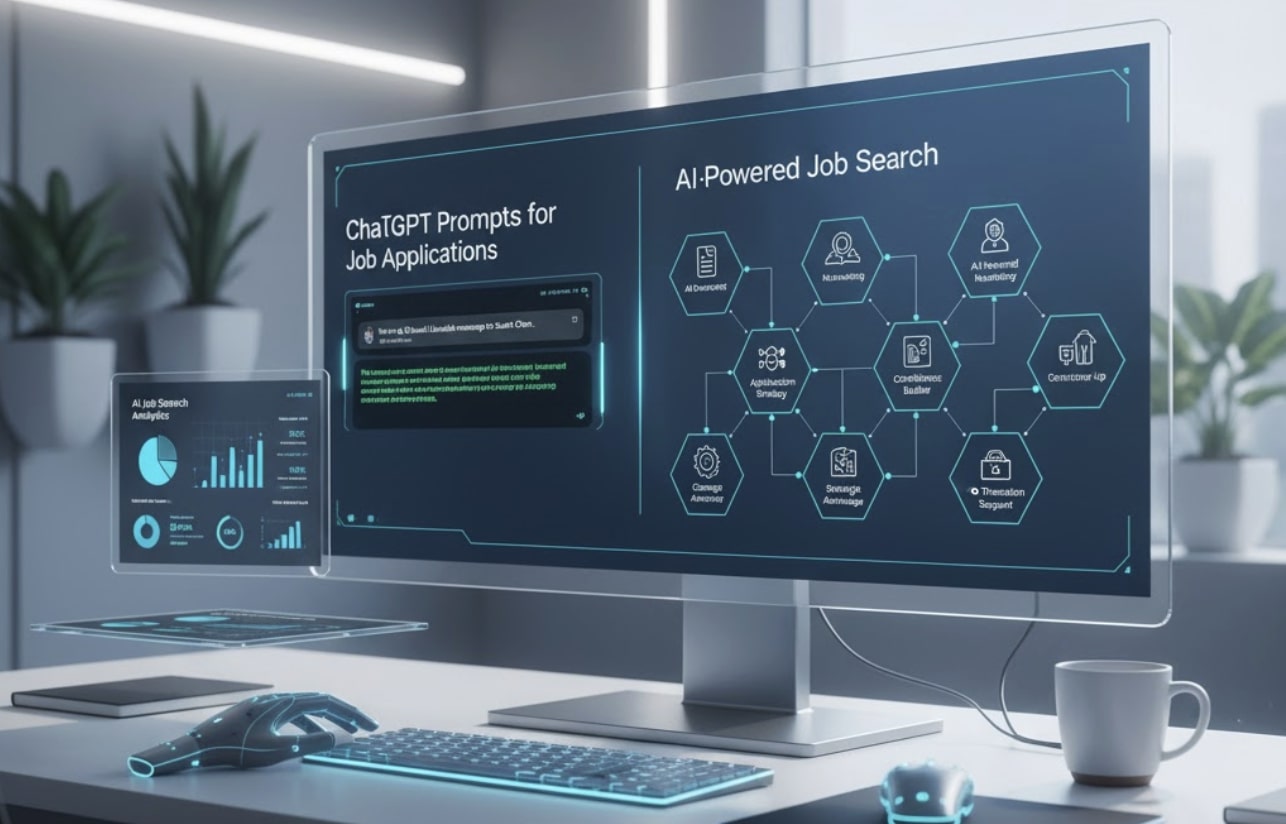Every minute, 250 resumes are uploaded to job boards worldwide, yet 75% never reach human eyes. The culprit? Applicant Tracking Systems (ATS) that filter out qualified candidates before recruiters even see their applications.
But here’s the game-changer: artificial intelligence is leveling the playing field. Modern AI tools can analyze job descriptions, optimize keywords, and format resumes to pass ATS filters with remarkable precision.
This comprehensive guide reveals exactly how to harness AI’s power to beat ATS systems. You’ll discover proven strategies, essential tools, and step-by-step processes that have helped thousands of job seekers increase their interview rates.
1. Understanding Applicant Tracking Systems in 2025
An Applicant Tracking System (ATS) is software that manages recruitment by automatically screening resumes against job requirements. These systems have evolved from simple keyword scanners into sophisticated AI-powered platforms that evaluate candidates across multiple criteria.
Current industry research shows that 98.8% of Fortune 500 companies use ATS technology, making it virtually impossible to avoid these systems in your job search.
- 98.8% Fortune 500 companies use ATS systems
- 75% Resumes are rejected before human review
- 43% Small businesses also use ATS platforms
- 68% Recruiters spend less than 30 seconds reviewing each resume
- 54% Job seekers don’t optimize for ATS compatibility
- 40% Increase in interview rates with ATS optimization
How Modern ATS Systems Work
Today’s ATS platforms use machine learning algorithms to evaluate resumes through multiple screening stages. They parse document structure, extract relevant information, and score candidates based on keyword relevance, experience matching, and qualification alignment.
The process typically involves three critical phases: parsing and extraction, where the system converts your resume into readable data; keyword matching, which compares your content against job requirements; and ranking algorithms that score your application against other candidates.
- Parsing Stage. ATS extracts text from your resume, converting it into structured data fields like contact information, work history, and skills.
- Keyword Analysis. The system compares your resume content against job description requirements, looking for exact matches and semantic similarities.
- Scoring Algorithm. Machine learning models assign relevance scores based on keyword density, experience relevance, and qualification matching.
- Ranking Process. Your application receives a numerical score that determines whether it advances to human review or gets filtered out.
Popular ATS Platforms You’ll Encounter
Understanding which ATS platforms companies use helps you optimize more effectively. Workday, Greenhouse, and Lever dominate the enterprise market, while smaller companies often use BambooHR or JazzHR.
| ATS Platform | Market Share | Key Features |
|---|---|---|
| Workday | 28% | AI-powered screening, integration-heavy |
| Greenhouse | 22% | Advanced analytics, structured interviews |
| Lever | 18% | Candidate relationship management |
| BambooHR | 12% | SMB-focused, user-friendly interface |
| JazzHR | 8% | Cost-effective, basic functionality |
| Others | 12% | Specialized or custom solutions |
2. The AI Revolution in Resume Optimization
Artificial intelligence has transformed resume optimization from guesswork into precise science. AI-powered tools can analyze thousands of job descriptions, identify keyword patterns, and generate optimized content that speaks directly to ATS algorithms.
These tools leverage natural language processing to understand job requirements beyond simple keyword matching. They analyze context, synonyms, and industry-specific terminology to ensure your resume aligns perfectly with employer expectations.
Why AI Beats Manual Optimization
Manual resume optimization is time-consuming and often ineffective. AI tools process information at speeds impossible for humans, analyzing multiple data points simultaneously to identify optimization opportunities you might miss.
- ✓ Processes job descriptions in seconds vs. hours manually
- ✓ Identifies hidden keywords and semantic matches
- ✓ Suggests industry-specific terminology and phrases
- ✓ Optimizes keyword density without compromising readability
- ✓ Adapts to different ATS parsing technologies
- ✓ Provides real-time scoring and improvement suggestions
Machine Learning’s Role in ATS Compatibility
Machine learning algorithms power modern resume optimization by learning from successful applications. These systems analyze millions of resumes and hiring outcomes to identify patterns that lead to interview invitations.
The most sophisticated AI tools use deep learning models trained on recruitment data to understand what works for specific industries, company sizes, and job levels. This intelligence helps create resumes that not only pass ATS filters but also resonate with human recruiters.
✔ AI Success Story
“After using AI optimization tools, my resume went from a 23% ATS compatibility score to 89%. I received three interview requests within two weeks, including one from my dream company. The AI identified critical keywords I’d completely missed and suggested powerful action verbs that made my experience sound more impactful.”
3. Essential AI Tools for ATS Optimization
The right AI tools can dramatically improve your ATS compatibility scores and interview rates. Leading platforms like JobWinner use algorithms from actual ATS systems to provide accurate optimization recommendations.
Modern AI resume tools offer features ranging from keyword optimization and formatting analysis to industry-specific suggestions and real-time scoring. The best platforms combine multiple AI technologies to deliver comprehensive optimization solutions.
Top-Rated AI Resume Optimization Platforms
| Platform | Key Features | Best For | Pricing |
|---|---|---|---|
| JobWinner | ATS simulation, keyword matching, LinkedIn optimization | Comprehensive ATS analysis | Free + Premium plans |
| Rezi | AI writing assistance, ATS-friendly templates | Complete resume building | $29/month |
| Enhancv | ChatGPT integration, visual design, content suggestions | Creative professionals | Free + Premium tiers |
| Teal | Job tracking, resume customization, career insights | Active job seekers | Free with premium features |
| ResumAI | AI content generation, format optimization | Quick optimization | Free basic version |
AI-Powered Keyword Research Tools
Keyword research is the foundation of ATS optimization. AI tools can analyze job descriptions to extract not just obvious keywords, but also semantic variations, industry terminology, and contextual phrases that ATS systems recognize.
These tools use natural language processing to understand the relationship between different terms. For example, they know that “team leadership” and “people management” might be equivalent in certain contexts, helping you optimize for variations.
- Primary Keywords. Direct matches from job descriptions like specific software names, certifications, or required skills.
- Semantic Keywords. Related terms and synonyms that ATS systems understand as equivalent or similar to primary keywords.
- Industry Jargon. Specialized terminology and acronyms commonly used in your target field or company.
- Action Verbs. Power words that demonstrate impact and align with job requirements and company culture.
Integration with Popular Job Boards
The most effective AI tools integrate directly with major job boards like LinkedIn, Indeed, and Glassdoor. This integration allows them to pull job descriptions automatically and provide tailored optimization suggestions for specific positions.
Some platforms offer browser extensions that work seamlessly with your job search workflow. These tools can analyze job postings in real-time and suggest resume modifications before you submit applications.
4. Step-by-Step AI Resume Optimization Process
Optimizing your resume with AI requires a systematic approach. This proven 8-step process has helped thousands of job seekers improve their ATS compatibility scores and land more interviews.
Each step builds upon the previous one, creating a comprehensive optimization strategy that addresses both technical ATS requirements and human readability. The entire process typically takes 2-3 hours but can increase your interview rate by 40% or more.
Step 1: Job Description Analysis
Begin by selecting 3-5 target job descriptions that represent your ideal positions. Copy the complete text into your chosen AI tool for comprehensive analysis. The AI will identify primary keywords, required skills, and preferred qualifications.
Look for patterns across multiple job descriptions. Keywords that appear frequently across different positions should be prioritized in your resume optimization. Pay special attention to specific technologies, certifications, and soft skills mentioned repeatedly.
- Step 1 Collect 3-5 relevant job descriptions
- Step 2 Upload descriptions to AI analysis tool
- Step 3 Review extracted keywords and phrases
- Step 4 Identify common themes and requirements
- Step 5 Prioritize keywords by frequency and relevance
- Step 6 Create master keyword list for optimization
Step 2: Current Resume Audit
Upload your existing resume to an AI-powered ATS checker. These tools will simulate actual ATS parsing and provide detailed feedback on formatting issues, keyword gaps, and optimization opportunities.
Most AI tools provide a compatibility score ranging from 0-100%. Scores below 75% typically indicate significant optimization needs, while scores above 85% suggest strong ATS compatibility.
Step 3: Keyword Integration Strategy
Strategically incorporate identified keywords throughout your resume using natural language patterns. Avoid keyword stuffing, which can make your resume sound robotic and reduce human readability.
Focus on integrating keywords in high-impact areas: professional summary, work experience bullet points, skills section, and relevant certifications. Use variations and synonyms to avoid repetition while maintaining keyword density.
| Resume Section | Keyword Strategy | Optimization Tips |
|---|---|---|
| Professional Summary | 3-5 primary keywords naturally integrated | Use industry terminology and action-oriented language |
| Work Experience | Keywords in context of achievements | Quantify results and use power verbs |
| Skills Section | Exact keyword matches from job descriptions | Separate technical and soft skills |
| Education/Certifications | Relevant credentials and training | Include completion dates and issuing organizations |
Step 4: Content Enhancement with AI
Use AI writing tools to enhance your resume content while maintaining authenticity. These tools can suggest powerful action verbs, help quantify achievements, and improve overall impact and readability.
AI-generated content should serve as inspiration rather than replacement. Always review and personalize AI suggestions to ensure they accurately represent your experience and maintain your unique voice.
✔ Before vs. After AI Enhancement
Before: “Responsible for managing team projects and meeting deadlines.”
After: “Led cross-functional team of 8 members to deliver 12 strategic projects on time, resulting in 25% improvement in operational efficiency and $150K cost savings.”
5. Advanced AI Techniques for Maximum ATS Success
Beyond basic optimization, advanced AI techniques can give you a significant competitive advantage. These strategies leverage cutting-edge technology to create resumes that not only pass ATS filters but also impress human recruiters.
Advanced optimization involves semantic analysis, contextual keyword placement, and industry-specific customization. These techniques require more sophisticated AI tools but can dramatically improve your success rate.
Semantic Optimization Beyond Keywords
Modern ATS systems use semantic analysis to understand context and meaning beyond exact keyword matches. AI tools can help you optimize for semantic relevance by suggesting related terms, industry concepts, and contextual phrases.
This approach ensures your resume demonstrates deep industry knowledge and comprehensive understanding of role requirements. AI can identify subtle connections between your experience and job requirements that might not be immediately obvious.
- Contextual Relationships. AI identifies connections between your skills and job requirements that go beyond surface-level keyword matching.
- Industry Terminology. Advanced tools suggest specialized language and acronyms that demonstrate insider knowledge of your field.
- Concept Clustering. AI groups related skills and experiences to create stronger thematic coherence throughout your resume.
- Relevance Scoring. Machine learning algorithms predict which content elements will have the highest impact on ATS scoring.
Dynamic Resume Customization
AI-powered platforms can automatically customize your resume for each application while maintaining consistency in your core message. This dynamic approach ensures optimal keyword alignment without requiring manual adjustments for every application.
Some advanced tools create resume variations automatically, adjusting keyword emphasis and content focus based on specific job requirements. This approach maximizes relevance while minimizing time investment.
AI-Driven A/B Testing
Sophisticated job seekers use AI tools to test different resume versions against the same job descriptions. This A/B testing approach helps identify which formatting choices, keyword strategies, and content structures perform best.
Track application response rates for different resume versions to identify optimization patterns. Data-driven optimization removes guesswork and focuses efforts on strategies that deliver measurable results.
6. Formatting and Structure for ATS Compatibility
Even perfectly optimized content can fail if your resume format confuses ATS parsing algorithms. ATS-friendly formatting ensures your information is correctly extracted and categorized during the screening process.
AI tools can analyze your resume structure and identify formatting issues that might cause parsing errors. Advanced ATS checkers simulate how different ATS platforms will interpret your resume layout.
ATS-Friendly Format Requirements
Stick to standard resume sections with clear headings that ATS systems recognize. Use conventional section names like “Work Experience,” “Education,” and “Skills” rather than creative alternatives that might confuse parsing algorithms.
Choose simple, clean fonts and avoid complex formatting elements. Standard fonts like Arial, Calibri, and Times New Roman ensure consistent rendering across different ATS platforms and viewing devices.
- ✓ Use standard Word document (.docx) or PDF format
- ✓ Stick to simple, clean fonts (Arial, Calibri, Times New Roman)
- ✓ Avoid tables, columns, headers, and footers
- ✓ Use standard section headings (Experience, Education, Skills)
- ✓ Include consistent date formats (MM/YYYY)
- ✓ Ensure proper spacing between sections
File Format Optimization
Choose the right file format based on application requirements. While PDF formats preserve formatting across platforms, some older ATS systems parse Word documents more effectively. When in doubt, follow the employer’s specific instructions.
Always save your resume with a professional filename that includes your name and the word “resume.” Avoid generic names like “Document1.docx” that don’t provide useful information to hiring managers.
Section Organization and Hierarchy
Organize your resume sections in logical order that matches ATS expectations and recruiter preferences. Start with contact information, followed by a professional summary, work experience, education, and skills.
| Section Order | Purpose | ATS Parsing Priority |
|---|---|---|
| Contact Information | Essential identification data | Critical – always parsed first |
| Professional Summary | Quick overview of qualifications | High – keyword-rich content |
| Work Experience | Detailed employment history | High – primary content area |
| Education | Academic credentials | Medium – varies by role level |
| Skills | Technical and soft skills | High – keyword matching |
| Certifications | Professional credentials | Medium – industry dependent |
7. Common ATS Mistakes to Avoid
Even well-intentioned optimization efforts can backfire if you make common ATS mistakes. Understanding these pitfalls helps you avoid strategies that might hurt rather than help your application success.
ATS optimization mistakes often stem from outdated advice or misunderstanding how modern systems work. The key is balancing ATS compatibility with human readability and authentic representation of your experience.
Keyword Stuffing and Over-Optimization
Excessive keyword repetition makes your resume sound unnatural and can trigger over-optimization penalties in sophisticated ATS systems. Modern algorithms are designed to detect and penalize obvious keyword stuffing attempts.
Focus on natural language integration that serves both ATS algorithms and human readers. Use keywords in context where they add genuine value rather than forcing them into every sentence.
- Warning Signs of Over-Optimization. Repetitive phrases, unnatural sentence structures, or keywords that don’t match your actual experience level.
- Quality Over Quantity. Better to use fewer keywords naturally than to force many keywords unnaturally throughout your resume.
- Context Matters. Keywords should enhance your story and demonstrate relevant experience rather than appearing randomly.
- Human-First Approach. Always prioritize readability and authenticity while incorporating ATS optimization strategies.
Formatting Errors That Break ATS Parsing
Complex formatting elements can confuse ATS parsing algorithms, causing important information to be missed or misinterpreted. Stick to simple, clean formatting that ensures consistent parsing across different ATS platforms.
Avoid using tables, text boxes, images, or unusual characters that might not transfer correctly during the parsing process. Clean, straightforward formatting is always the safest approach for ATS compatibility.
Inconsistent Contact Information
Ensure your contact information is consistent across your resume, cover letter, and online profiles. Discrepancies in contact details can create confusion and make it difficult for recruiters to reach you.
Include a professional email address and current phone number. Avoid using outdated information or email addresses that might reflect poorly on your professionalism.
8. Measuring and Improving Your ATS Performance
Successful ATS optimization requires continuous monitoring and improvement. Performance tracking helps you identify what’s working and where adjustments are needed to maximize your interview success rate.
Use data-driven approaches to refine your optimization strategy. Track application response rates, interview invitations, and feedback to identify patterns and optimization opportunities.
Key Performance Metrics to Track
Monitor specific metrics that indicate ATS performance and overall application success. Response rate tracking helps you understand which optimization strategies deliver the best results for your target roles.
- Response Rate Percentage of applications that receive any response
- Interview Rate Applications that result in interview invitations
- ATS Score Compatibility ratings from optimization tools
- Time to Response How quickly employers respond to applications
- Application Volume Number of applications submitted per week
- Quality Score Relevance match between your profile and positions
You can easily track application success with JobWinner Job Tracker, which automatically organizes your applications and helps you monitor your progress over time.
A/B Testing Different Resume Versions
Create multiple resume versions optimized for different types of positions or companies. A/B testing helps identify which approaches work best for your specific career goals and target market.
Test variations in keyword emphasis, formatting styles, and content organization. Use career platform analytics to track which versions generate the highest response rates.
| Test Variable | Version A | Version B | Success Metric |
|---|---|---|---|
| Professional Summary | Skills-focused opening | Achievement-focused opening | Interview rate comparison |
| Keyword Density | High keyword concentration | Moderate keyword use | ATS compatibility scores |
| Format Style | Traditional chronological | Hybrid functional format | Response rate tracking |
| Section Order | Experience before education | Education before experience | Recruiter engagement metrics |
AI-Powered Prompts for ATS Optimization
Use these proven AI prompts to optimize different aspects of your resume for maximum ATS compatibility. These prompts work with popular AI tools like ChatGPT, Claude, and Bard to generate ATS-friendly content.
✔ AI Prompt #1: Keyword Optimization
“Analyze this job description [paste job description] and identify the top 15 most important keywords and phrases. Then review my current resume [paste resume] and suggest specific ways to naturally integrate these keywords into my professional summary, work experience, and skills sections while maintaining readability and authenticity. Provide the exact revised text for each section.”
✔ AI Prompt #2: Achievement Enhancement
“Transform these basic job responsibilities [paste current bullet points] into achievement-focused statements that include quantifiable results and power verbs. Optimize each bullet point for ATS keywords related to [specific role/industry] while ensuring they accurately represent realistic accomplishments. Use action verbs that demonstrate impact and leadership.”
Continuous Improvement Strategies
Regular optimization reviews help you stay current with evolving ATS technology and industry requirements. Monthly resume audits ensure your content remains competitive and aligned with market demands.
Stay informed about ATS updates and new optimization techniques. Join professional groups, follow industry experts, and regularly test your resume against current ATS standards to maintain peak performance.
Conclusion: Your ATS Success Action Plan
Mastering ATS optimization with AI tools is no longer optional in today’s competitive job market. The strategies outlined in this guide provide a comprehensive framework for passing ATS filters and landing more interviews.
Start with the fundamentals: choose the right AI tools, optimize your keywords strategically, and maintain clean formatting. Then advance to sophisticated techniques like semantic optimization and dynamic customization to gain a competitive edge.
Remember that ATS optimization is an ongoing process, not a one-time task. Regular updates, performance monitoring, and continuous improvement ensure your resume remains effective as technology and industry requirements evolve.
- Week 1: Foundation. Set up AI optimization tools, audit your current resume, and identify improvement opportunities.
- Week 2: Implementation. Apply keyword optimization, improve formatting, and create ATS-compatible versions of your resume.
- Week 3: Testing. Begin tracking application metrics and testing different resume versions with real job applications.
- Ongoing: Optimization. Monitor performance, refine strategies, and stay current with ATS technology developments.
Frequently Asked Questions
Q: How do I know if my resume is ATS-compatible?
Use AI-powered ATS checkers like JobWinner to get compatibility scores. These tools simulate actual ATS parsing and provide detailed feedback. Scores above 75% typically indicate good ATS compatibility, while scores below 60% suggest significant optimization needs.
Q: Should I use different resume versions for different jobs?
Yes, customizing your resume for each application significantly improves success rates. Use AI tools to quickly identify key differences between job descriptions and adjust your keywords accordingly. Focus on matching the most important qualifications and terminology.
Q: Can AI tools completely rewrite my resume?
AI tools should enhance rather than replace your content. Use them for keyword suggestions, formatting optimization, and content improvement, but ensure the final result authentically represents your experience and maintains your unique voice.
Q: What’s the biggest mistake people make with ATS optimization?
Keyword stuffing is the most common mistake. Over-optimization makes resumes sound unnatural and can trigger penalties in sophisticated ATS systems. Focus on natural integration of relevant keywords that genuinely represent your skills and experience.
Q: How often should I update my ATS optimization strategy?
Review your strategy monthly and update your resume quarterly, or whenever you’re actively job searching. ATS technology evolves continuously, and regular updates ensure your optimization remains effective.
Q: Are PDF or Word documents better for ATS systems?
Both formats work well with modern ATS systems, but follow employer instructions when specified. Word documents (.docx) are generally safer for older systems, while PDFs preserve formatting better across different viewing platforms.
Q: Do creative industries need different ATS strategies?
Creative industries still use ATS systems, but they may value portfolio links and creative skills more heavily. Maintain ATS compatibility while highlighting relevant creative tools, software, and project outcomes that demonstrate your artistic and technical abilities.
Q: How long should an ATS-optimized resume be?
For most professionals, 1-2 pages is optimal. ATS systems can parse longer resumes, but recruiters prefer concise documents. Focus on the most relevant 10-15 years of experience and prioritize achievements that align with your target roles.
Q: Can ATS systems detect AI-generated content?
Current ATS systems don’t specifically detect AI-generated content, but obvious AI writing patterns might seem inauthentic to human recruiters. Use AI as a tool for enhancement while ensuring your resume maintains your personal voice and accurately represents your experience.
Q: What should I do if I’m not getting responses despite ATS optimization?
If optimization isn’t improving response rates, consider broader factors: are you applying to appropriate positions, is your experience level aligned with requirements, and are you following application instructions correctly? Sometimes the issue is role targeting rather than resume optimization.












